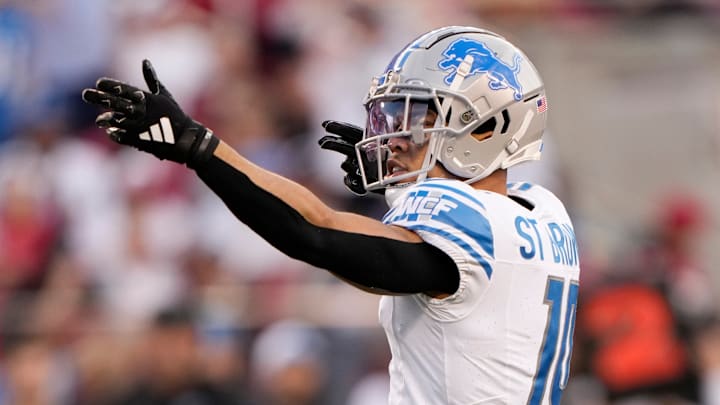When we think of a No. 1, "alpha" wide receiver" in the NFL, we definitely get a picture in our minds. He has size, all-around ability to dominate every are of the field, he has a dominant target share and he tilts coverage in his direction. In Detroit Lions' history, Calvin Johnson fully embodies the idea of what a No. 1 wide receiver is.
These days the Lions' top wide receiver, Amon-Ra St. Brown, is an antithesis of what we think of when we picture a No. 1 receiver. He should not be pigeonholed as just a slot receiver, but otherwise he does not fit the general physical template or skill set of the role.
And as we've seen the last two seasons, it works just fine for the Lions to not have what would strictly be defined as a No. 1 wide receiver. Ben Johnson deploys a variety of formations and personnel groupings, and generally nothing is off-limits in terms of play calls out of any formation.
Doug Farrar of SB Nation dove into the concept of why NFL teams don't need a No. 1 wide receiver anymore. Part of that idea is the relative dearth of receivers who fill the bill completely. The quarterback has freedom to throw to whoever is open, without having to appease a certain receiver to the potential detriment of everyone and everything else in the offense.
Detroit Lions are poster child for not needing a true No. 1 receiver
Farrar also used the Green Bay Packers, Kansas City Chiefs and San Francisco 49ers as examples of his concept. But the Lions are an automatic example too.
"Detroit Lions offensive coordinator Ben Johnson has been turning down head coaching jobs of late – perhaps because he realizes that as much as he’s done with his playbook to amplify Detroit’s offense, he’ll be able to pick his spot in a relative sense....In Johnson’s offense, the Lions ran a lot of 11 personnel (one running back, one tight end, three receivers) and 12 personnel (one running back, two tight ends, two receivers). They ranked third in 3x1 formation snaps behind the Chiefs and the Washington Commanders with 515, and they ranked third in 2x2 formation snaps behind the Philadelphia Eagles and the Indianapolis Colts with 627. Factor in Johnson’s multi-faceted run game, and there isn’t one book on the Lions’ offense – making everything more difficult to read."
The @Lions ranked third in the NFL last season in 3x1 sets, and third in 2x2 sets. 2x2 is where of a lot of Ben Johnson's brilliant route and spacing concepts showed up -- like on this 63-yard completion from Jared Goff to Jameson Williams against the Cowboys. pic.twitter.com/11vAnj3EXn
— Doug Farrar ✍ (@NFL_DougFarrar) July 1, 2024
The "No. 1" wide receiver in an offense is often the "X" receiver, or the split end who lines up on the line of scrimmage on the weak side of the formation (opposite the tight end, if there's only one).
With a fantasy football spin, Pro Football Focus' Nathan Jahnke took a deep look at wide receiver utilization and production based on role ("X", "Z", slot). He charted "Team X Receiver Consistency" over the last three seasons, with an average over the three campaigns. Here's how Jahnke defined that metric.
"How often the X receiver on a play was a lead X receiver in two- or three-receiver sets for the game, ordered by the three-year average."
It's not surprising the Lions were dead-last on that chart, with their X receiver being a "lead X" 60.5 percent over the three-season span. The Chiefs are second to last and the Miami Dolphins are fourth to last on Jahnke's "X Receiver Consistency" chart from 2021-2023, which further reinforces Farrar's point about teams not really needing a true, unchallenged, No. 1 receiver to have a high-level offense.
With the set of skill position talent they have, the Lions are the poster child for not needing what would be defined as a true No. 1 wide receiver.
